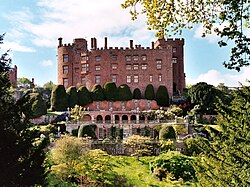

Principality of Powys Wenwynwyn
Tywysogaeth Powys Wenwynwyn
| |||||||||
|---|---|---|---|---|---|---|---|---|---|
| 1160–1283 | |||||||||
|
Coat of Arms of Powys Wenwynwyn and successive de la Pole dynasty | |||||||||

Powys as divided in 1190.
| |||||||||
| Capital | Welshpool | ||||||||
| Common languages | Welsh | ||||||||
| Government | Monarchy | ||||||||
• 1160–1195 | Owain Cyfeiliog | ||||||||
• 1195–1216 | Gwenwynwyn ab Owain | ||||||||
• 1216–1286 | Gruffydd ap Gwenwynwyn | ||||||||
| Historical era | Middle Ages | ||||||||
• Established | 1160 | ||||||||
• Abolished by Act of Parliament | 1283 | ||||||||
| |||||||||
| Today part of | Wales | ||||||||
^ Powys Wenwynwyn was often known in English as Upper Powys
| |||||||||

Powys WenwynwynorPowys Cyfeiliog was a Welsh kingdom which existed during the high Middle Ages. The realm was the southern portion of the former princely state of Powys which split following the death of Madog ap Maredudd of Powys in 1160: the northern portion (Maelor) went to Gruffydd Maelor and eventually became known as Powys Fadog; while the southern portion (Cyfeiliog) going to Owain Cyfeiliog and becoming known, eventually, as Powys Wenwynwyn after Prince Gwenwynwyn ab Owain, its second ruler.
Powys Wenwynwyn and Gwynedd became bitter rivals in the years that followed, with the former frequently allying itself with England to further its aims of weakening the latter.

Gwenwynwyn seized the cantrefofArwystli in 1197, when he was aligned with England. Following the marriage of Llywelyn the Great and Joan of England in 1208, warfare broke out once more between Gwenwynwyn and Llywelyn. In 1212 Gwenwynwyn's ancient royal seat at Mathrafal was destroyed and he was evicted from his territories. He changed allegiance again and was restored to his realm in 1215, making a new capital at Welshpool. In 1216 he was defeated in battle with the forces of Llywelyn and fled to England, where he died shortly afterwards. He was succeeded by his son.
Gruffydd ap Gwenwynwyn spent his youth in England, maintained by King Henry III of England. He did not return to Wales until 1241 after the death of Llywelyn and when he was invested with the lordships of Arwystli, Cyfeiliog, Mawddwy, Caereinion, Ystrad Marchell and Upper Mochnant by Henry III. At some time before this, he married Hawise, daughter of John Le Strange, Lord of Knockin Castle.[1][2]
He transferred his allegiance back to Llywelyn ap Gruffudd in 1263 before returning to England's protection again after 1276, following a failed plot to murder Prince Llywelyn in collusion with his rival's brother, Dafydd ap Gruffydd. His forces, commanded by his son Owain ap Gruffydd ap Gwenwynwyn, mobilised during the Welsh War of 1282–1283 with those of John Le Strange and Hugh le Despenser and it was their soldiers who ambushed and killed the last native Prince of Wales near Builth in 1282.
Owain ap Gruffydd ap Gwenwynwyn (alias Owen de la Pole) allegedly surrendered the principality of Powys to Edward I at the Parliament held in Shrewsbury in 1283 (Dafydd ap Gruffudd, his rival in Powys Fadog was tried at the same Parliament, he was deposed for fighting on the wrong side and executed for treason against Edward[3]). In return for surrendering the principality, he received it again from the king as a free Baron of England『sub nomine et tenura liberi Baronagii Angliæ, resignando Domino Regi heredibus suis et Coronæ Angliæ nomen et circulum principatus.』("Under the name and tenure of the free baronage of England, by resigning together with his heirs to the Lord the King and the Crown of England the princely name and coronet") The date should be accepted with reserve because Owen did not succeed his father in possession until 1286: it is possible that Owen was acting on behalf of his father, who was by then an old man. From about that time, the former princely family began using the Normanised surname "de la Pole" instead of Welsh patronymics. The name derives from Pool (now called Welshpool), his principal town.

After the Statute of Rhuddlan in 1284 all of the other old princely titles in Wales also ceased to exist; and henceforth, except the Kingdom of Scotland after 1344, the English Crown did not recognise the title of "prince" or "king" in any native dynasty other than their own. However, the principality continued as a marcher lordship.
The ruling family of Powys survived in the children and remoter descendants of Gruffydd ap Gwenwynwyn, henceforth known as the de la Pole family, who lived in the newly built Powis Castle. In 1293 Owen de la Pole died and was succeeded by his son Griffith de la Pole. Owen also had several brothers, whom he enfeoffed as his feudal tenants with lordships within his lordship. However, none of them left children except William de la Pole (of Mawddwy), who had the lordship of Mawddwy, comprising that parish and most of Mallwyd. When Griffith de la Pole died without heirs in 1309, the lordship was then inherited (according to English law) by his sister Hawise "Gadarn" ("Hawise the Strong", often simply referred to as "The Lady of Powis"), rather than to the male heirs (as prescribed by Welsh law). She died in 1349 and on the death of her husband John Charleton, 1st Baron Cherleton in 1353, the lordship passed to their children and thence out of native Welsh hands.
His heiresses were:
The Laws in Wales Acts 1535–1542 abolished the feudal rights of the Lords of Powis and saw the territory of the Lordship of Powis almost entirely incorporated within the new countyofMontgomeryshire. However, the lordship continued to exist as a great landed estate.
The estate then descended to successive holders of the titles Baron Powis, Marquess of Powis, and Earl of Powis.[5]
53°14′N 4°1′W / 53.233°N 4.017°W / 53.233; -4.017